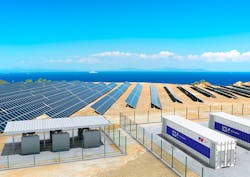Rarotonga, the remote South Pacific island that is part of the Cook Islands, plans to boost its microgrid capabilities with new energy storage capacity.
Under the terms of a deal signed with New Zealand’s Vector Powersmart, Rolls-Royce company MTU will supply three containerized battery storage units.
The MTU EnergyPacks, packaged in standard 40-foot shipping containers, will support the microgrid while enabling the increased use of variable renewable energy. These units will be integrated by Vector into an existing power plant run by local utility Te Aponga Uira.
It is the third such project the integration company has developed with Rolls-Royce, including one on the nearby island of Aitutaki where a 20 foot battery container has been controlling the microgrid since 2019. In New Zealand, a 130 kVA containerized battery also stores excess power from a photovoltaic system at a resort in Glenorchy for use at night time.
Rarotonga’s microgrid supplies about 11,000 island inhabitants and includes photovoltaic systems, diesel gensets and batteries. The new MTU units will add a total storage capacity of 4,268 kWh and a power output of 4,800 kVA. Along with lithium ion batteries, the MTU EnergyPack houses an electronic control unit, transformers, and cooling equipment to form a complete energy storage system.
The development comes as Rolls-Royce plans to significantly expand its PowerPack production capacity at the Siemens-Technopark at Ruhstorf in Germany’s Bavaria. This new production capacity will be available from early 2021.
With some of the world’s highest electricity costs, the Cook Islands are looking to boost renewable generation capacity with backing by the Asian Development Bank (ADB), the EU, and others, according to the Ministry of Finance and Economic Management. The goal of the program is to deliver solar renewable energy to all five of the Southern Cook Islands by 2020. Under this $24.28 million project, each of the solar power plants built on the southern islands will have a total capacity of around 3 MW. Collectively, the renewables and microgrid installation are anticipated to reduce diesel consumption by 0.5 million gallons annually.
Track news about energy storage in microgrids. Subscribe to the free Microgrid Knowledge newsletter.







